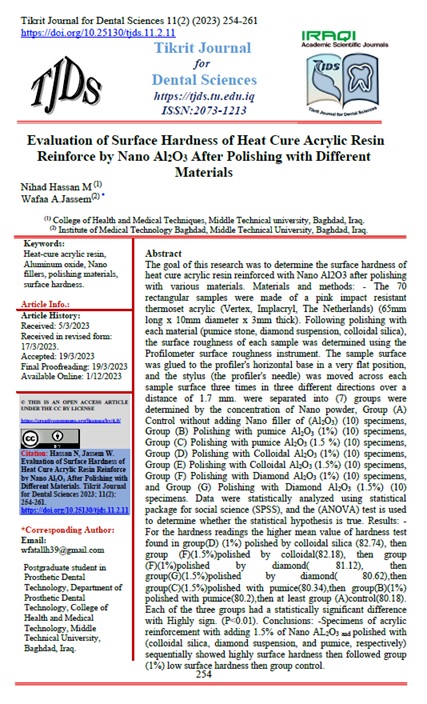Evaluation of Surface Hardness of Heat Cure Acrylic Resin Reinforce by Nano Al2O3 After Polishing with Different Materials
Nihad Hassan M
(1) College of Health and Medical Techniques, Middle Technical university, Baghdad, Iraq.
Wafaa A.Jassem
Institute of Medical Technology Baghdad, Middle Technical University, Baghdad, Iraq.
DOI: https://doi.org/10.25130/tjds.11.2.11
Keywords: Heat-cure acrylic resin, Aluminum oxide, Nano fillers, polishing materials, surface hardness.
Abstract
The goal of this research was to determine the surface hardness of heat cure acrylic resin reinforced with Nano Al2O3 after polishing with various materials. Materials and methods: - The 70 rectangular samples were made of a pink impact resistant thermoset acrylic (Vertex, Implacryl, The Netherlands) (65mm long x 10mm diameter x 3mm thick). Following polishing with each material (pumice stone, diamond suspension, colloidal silica), the surface roughness of each sample was determined using the Profilometer surface roughness instrument. The sample surface was glued to the profiler's horizontal base in a very flat position, and the stylus (the profiler's needle) was moved across each sample surface three times in three different directions over a distance of 1.7 mm. were separated into (7) groups were determined by the concentration of Nano powder, Group (A) Control without adding Nano filler of (Al2O3) (10) specimens, Group (B) Polishing with pumice Al2O3 (1%) (10) specimens, Group (C) Polishing with pumice Al2O3 (1.5 %) (10) specimens, Group (D) Polishing with Colloidal Al2O3 (1%) (10) specimens, Group (E) Polishing with Colloidal Al2O3 (1.5%) (10) specimens, Group (F) Polishing with Diamond Al2O3 (1%) (10) specimens, and Group (G) Polishing with Diamond Al2O3 (1.5%) (10) specimens. Data were statistically analyzed using statistical package for social science (SPSS), and the (ANOVA) test is used to determine whether the statistical hypothesis is true. Results: - For the hardness readings the higher mean value of hardness test found in group(D) (1%) polished by colloidal silica (82.74), then group (F)(1.5%)polished by colloidal(82.18), then group (F)(1%)polished by diamond( 81.12), then group(G)(1.5%)polished by diamond( 80.62),then group(C)(1.5%)polished with pumice(80.34),then group(B)(1%) polished with pumice(80.2),then at least group (A)control(80.18). Each of the three groups had a statistically significant difference with Highly sign. (P<0.01). Conclusions: -Specimens of acrylic reinforcement with adding 1.5% of Nano AL2O3 and polished with (colloidal silica, diamond suspension, and pumice, respectively) sequentially showed highly surface hardness then




